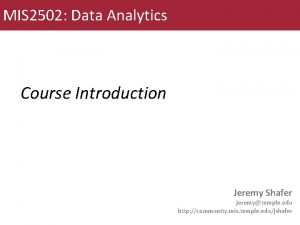Yu G Shafer Institute for Cosmophysical Research and












- Slides: 12

Yu. G. Shafer Institute for Cosmophysical Research and Aeronomy SB RAS Dynamics of the galactic cosmic ray intensity in presence of solar wind disturbances. Petukhov I. S. , Petukhov S. I. 21 st European Cosmic Ray Symposium in Košice, Slovakia 9 - 12 September 2008

Introduction � Study of cosmic rays intensity dynamics with large-scale disturbance of solar wind is of a grate interest in connection with the possibility to use the results for prediction of interplanetary disturbances and pre-decrease of CR intensity as a precursors are revealed for a sufficiently large number of individual events.

Disturbance Shock front Undisturbed Solar wind Sun Reflected CR Earth magnetosphere Interplanetary magnetic field Escaped CR from FD region Used model of the Shock:

Shock front Variation CR Reflected CR Escaped CR Vs Reflected CR

� Cosmic ray trajectories are calculated by means of numerical integration of an equation system of relativistic protons movement by the Runge-Kutta method of the forth accuracy order. � Magnetic field of quiet solar wind is of Parker type, with constant flow velocity being radial and equal 400 km/sec. Electric field of solar wind is defined using a frozen condition. � The disturbance is shock wave which given in the shape of an ellipsoid. � When calculating particle drift at the shock front, electromagnetic field in the region behind the front is determined using the Rankine-Huhoniot relation.

Dynamics of particles trajectories on the Earth magnetosphere surface at the presence of approaching interplanetary shock a) Rs = 0. 5 AU; b) Rs = 0. 7 AU; c) Rs = 0. 9 AU ↑ - blue upwards arrow – reflected particle ↓ - red downwards arrow – particle escaped from FD region = - equal – undisturbed particle

Viewing cone connects the certain area on the magnetosphere surface by means of cosmic rays with corresponding ground detector. Position and configuration of this area depend on CRs energies, detector geographic coordinates and universal time. For determination of viewing cone CR trajectories are calculated in Earth magnetic field presented by 8 -th harmonics of Tsiganenko model for 2000 -th epoch.

Primary CR Earth rotation Viewing cone Ground detector Magnetosphere surface

Comparison calculated results with observational data of ground detectors � Neutron monitors and muon detectors measure the intensity of secondary particles (neutron and muons) produced by interactions of primary cosmic rays with atoms in Earth’s atmosphere. Calculated CR intensity variation is determined by: 1) integrating on solid angle using dependence of secondary particles intensity with polar angle I=cos(Theta)^6 for neutrons or cos(Theta)^2 for muons; 2) integrating on energy using coupling coeffitiens for neutrons (Quenby-Webber coupling coefficients) or for muons Where - differential variation; W(ε) - coupling coefficients; - geomagnetic cutoff energy.

Event 09. 1992 (Nagashima K. et al. , 1993)

Positive Apparently from comparison calculations well reproduce time sequence of CR intensity variations, measured by various detectors. Sizes of falls CR intensity, measured by detectors before shock wave arrival into an orbit of the Earth quite well correspond. Negative The calculated CR intensity variations during the different moments of time for neutron monitor Norikura and muon telescop Nagoya considerably differ one from another on size, that speaks that expansion of the area of corresponding CR trajectories a magnetosphere surface in process of shock wave approach. Absence of the calculated variation of CR intensity for the neutron monitor of station to Thule

Conclusion Calculated results are in general agreement with the CR intensity variation registered by ground-level detectors. The method of CR trajectories for describing CR intensity dynamics with solar wind large-scale disturbances is useful and adequate since the mean free path is long enough for highenergy particles to carry the directional intensity information from an interplanetary disturbance to the Earth.
 Traditional software testing
Traditional software testing Kontradiksi
Kontradiksi Jeremy shafer
Jeremy shafer Jane schaffer one chunk paragraph
Jane schaffer one chunk paragraph Wade shafer
Wade shafer Gennifer shafer liver disease
Gennifer shafer liver disease Resources scarcity
Resources scarcity Seth shafer
Seth shafer Sagar institute of research and technology
Sagar institute of research and technology Electronics and telecommunications research institute
Electronics and telecommunications research institute Target institute of medical education and research
Target institute of medical education and research Prof ram meghe institute of technology and research
Prof ram meghe institute of technology and research Swedish national road and transport research institute
Swedish national road and transport research institute




















